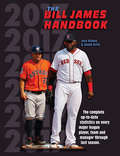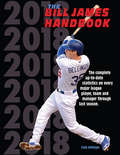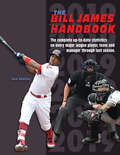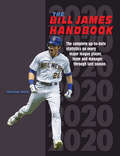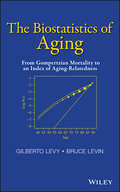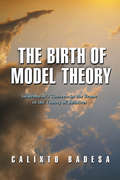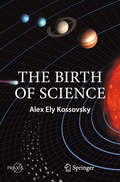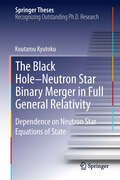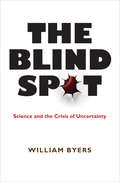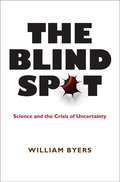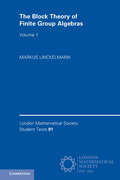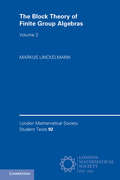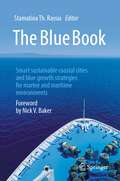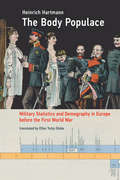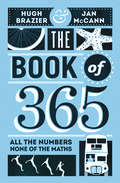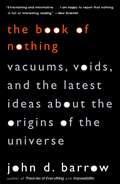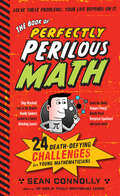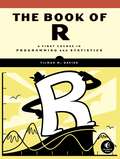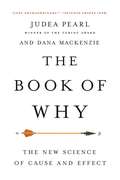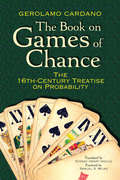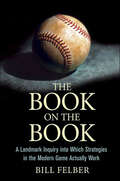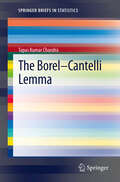- Table View
- List View
The Bill James Handbook 2017
by Bill James Baseball Info SolutionsBill James and the Baseball Info Solutions team of analysts continue to pack in new content, including a fresh look at the continued rise and effectiveness of The Shift and a new breakdown of home runs and long flyouts. And, as always, the book forecasts fresh hitter and pitcher projections for those looking to get an early jump on the next season.
The Bill James Handbook 2018
by Bill James Baseball Info SolutionsBill James and Baseball Info Solutions team of analysts continue to pack in new content, including a fresh look at the continues rise and effectiveness of The Shift and a new breakdown of home runs and long flyouts. And, as always, the book forecasts fresh hitter and pitcher projections for those looking to get an early jump on the next season.</
The Bill James Handbook 2019
by Bill James Baseball Info SolutionsBill James and Baseball Info Solutions team of analysts continue to pack in new content, including a fresh look at the continues rise and effectiveness of The Shift and a new breakdown of home runs and long flyouts. And, as always, the book forecasts fresh hitter and pitcher projections for those looking to get an early jump on the next season.</
The Bill James Handbook 2020
by Bill James Baseball Info SolutionsThe first-to-market, most comprehensive, insightful, and groundbreaking annual baseball book on the market. A must-have book or gift for every true fan, with lifetime statistics and leader boards for every player in the major leagues and projections for how they might do in the future.
The Biostatistics of Aging
by Bruce Levin Gilberto LevyA practical and clarifying approach to aging and aging-related diseasesProviding a thorough and extensive theoretical framework, The Biostatistics of Aging: From Gompertzian Mortality to an Index of Aging-Relatedness addresses the surprisingly subtlenotion--with consequential biomedical and public health relevance--of what it means for acondition to be related to aging. In this pursuit, the book presents a new quantitative methodto examine the relative contributions of genetic and environmental factors to mortality anddisease incidence in a population.With input from evolutionary biology, population genetics, demography, and epidemiology, this medically motivated book describes an index of aging-relatedness and also features:Original results on the asymptotic behavior of the minimum of time-to-event random variables, which extends those of the classical statistical theory of extreme valuesA comprehensive and satisfactory explanation based on biological principles of the Gompertz pattern of mortality in human populationsThe development of an evolution-based model of causation relevant to mortality and aging-related diseases of complex etiologyAn explanation of how and why the description of human mortality by the Gompertz distribution can be improved upon from first principlesThe amply illustrated analysis of real-world data, including a program for conducting the analysis written in the freely available R statistical softwareTechnical appendices including mathematical material as well as an extensive and multidisciplinary bibliography on aging and aging-related diseasesThe Biostatistics of Aging: From Gompertzian Mortality to an Index of Aging-Relatedness is an excellent resource for practitioners and researchers with an interest in aging and aging-related diseases from the fields of medicine, biology, gerontology, biostatistics, epidemiology, demography, and public health.
The Birth of Model Theory: Löwenheim's Theorem in the Frame of the Theory of Relatives
by Calixto BadesaLöwenheim's theorem reflects a critical point in the history of mathematical logic, for it marks the birth of model theory--that is, the part of logic that concerns the relationship between formal theories and their models. However, while the original proofs of other, comparably significant theorems are well understood, this is not the case with Löwenheim's theorem. For example, the very result that scholars attribute to Löwenheim today is not the one that Skolem--a logician raised in the algebraic tradition, like Löwenheim--appears to have attributed to him. In The Birth of Model Theory, Calixto Badesa provides both the first sustained, book-length analysis of Löwenheim's proof and a detailed description of the theoretical framework--and, in particular, of the algebraic tradition--that made the theorem possible. Badesa's three main conclusions amount to a completely new interpretation of the proof, one that sharply contradicts the core of modern scholarship on the topic. First, Löwenheim did not use an infinitary language to prove his theorem; second, the functional interpretation of Löwenheim's normal form is anachronistic, and inappropriate for reconstructing the proof; and third, Löwenheim did not aim to prove the theorem's weakest version but the stronger version Skolem attributed to him. This book will be of considerable interest to historians of logic, logicians, philosophers of logic, and philosophers of mathematics.
The Birth of Science (Springer Praxis Books)
by Alex Ely KossovskyThis book reveals the multi-generational process involved in humanity's first major scientific achievement, namely the discovery of modern physics, and examines the personal lives of six of the intellectual giants involved. It explores the profound revolution in the way of thinking, and in particular the successful refutation of the school of thought inherited from the Greeks, which focused on the perfection and immutability of the celestial world. In addition, the emergence of the scientific method and the adoption of mathematics as the central tool in scientific endeavors are discussed. The book then explores the delicate thread between pure philosophy, grand unifying theories, and verifiable real-life scientific facts. Lastly, it turns to Kepler’s crucial 3rd law and shows how it was derived from a mere six data points, corresponding to the six planets known at the time. Written in a straightforward and accessible style, the book will inform and fascinate all aficionados of science, history, philosophy, and, in particular, astronomy.
The Black Hole-Neutron Star Binary Merger in Full General Relativity
by Koutarou KyutokuThis thesis presents a systematic study of the orbital evolution, gravitational wave radiation, and merger remnant of the black hole-neutron star binary merger in full general relativity for the first time. Numerical-relativity simulations are performed using an adaptive mesh refinement code, SimulAtor for Compact objects in Relativistic Astrophysics (SACRA), which adopts a wide variety of zero-temperature equations of state for the neutron star matter. Gravitational waves provide us with quantitative information on the neutron star compactness and equation of state via the cutoff frequency in the spectra, if tidal disruption of the neutron star occurs before the binary merges. The cutoff frequency will be observed by next-generation laser interferometric ground-based gravitational wave detectors, such as Advanced LIGO, Advanced VIRGO, and KAGRA. The author has also determined that the mass of remnant disks are sufficient for the remnant black hole accretion disk to become a progenitor of short-hard gamma ray bursts accompanied by tidal disruptions and suggests that overspinning black holes may not be formed after the merger of even an extremely spinning black hole and an irrotational neutron star.
The Blind Spot
by William ByersIn today's unpredictable and chaotic world, we look to science to provide certainty and answers--and often blame it when things go wrong. The Blind Spot reveals why our faith in scientific certainty is a dangerous illusion, and how only by embracing science's inherent ambiguities and paradoxes can we truly appreciate its beauty and harness its potential. Crackling with insights into our most perplexing contemporary dilemmas, from climate change to the global financial meltdown, this book challenges our most sacredly held beliefs about science, technology, and progress. At the same time, it shows how the secret to better science can be found where we least expect it--in the uncertain, the ambiguous, and the inevitably unpredictable. William Byers explains why the subjective element in scientific inquiry is in fact what makes it so dynamic, and deftly balances the need for certainty and rigor in science with the equally important need for creativity, freedom, and downright wonder. Drawing on an array of fascinating examples--from Wall Street's overreliance on algorithms to provide certainty in uncertain markets, to undecidable problems in mathematics and computer science, to Georg Cantor's paradoxical but true assertion about infinity--Byers demonstrates how we can and must learn from the existence of blind spots in our scientific and mathematical understanding. The Blind Spot offers an entirely new way of thinking about science, one that highlights its strengths and limitations, its unrealized promise, and, above all, its unavoidable ambiguity. It also points to a more sophisticated approach to the most intractable problems of our time.
The Blind Spot: Science and the Crisis of Uncertainty
by William ByersIn today's unpredictable and chaotic world, we look to science to provide certainty and answers--and often blame it when things go wrong. The Blind Spot reveals why our faith in scientific certainty is a dangerous illusion, and how only by embracing science's inherent ambiguities and paradoxes can we truly appreciate its beauty and harness its potential. Crackling with insights into our most perplexing contemporary dilemmas, from climate change to the global financial meltdown, this book challenges our most sacredly held beliefs about science, technology, and progress. At the same time, it shows how the secret to better science can be found where we least expect it--in the uncertain, the ambiguous, and the inevitably unpredictable. William Byers explains why the subjective element in scientific inquiry is in fact what makes it so dynamic, and deftly balances the need for certainty and rigor in science with the equally important need for creativity, freedom, and downright wonder. Drawing on an array of fascinating examples--from Wall Street's overreliance on algorithms to provide certainty in uncertain markets, to undecidable problems in mathematics and computer science, to Georg Cantor's paradoxical but true assertion about infinity--Byers demonstrates how we can and must learn from the existence of blind spots in our scientific and mathematical understanding. The Blind Spot offers an entirely new way of thinking about science, one that highlights its strengths and limitations, its unrealized promise, and, above all, its unavoidable ambiguity. It also points to a more sophisticated approach to the most intractable problems of our time.
The Bloch-Kato Conjecture for the Riemann Zeta Function
by John Coates A. Raghuram Anupam Saikia R. SujathaThere are still many arithmetic mysteries surrounding the values of the Riemann zeta function at the odd positive integers greater than one. For example, the matter of their irrationality, let alone transcendence, remains largely unknown. However, by extending ideas of Garland, Borel proved that these values are related to the higher K-theory of the ring of integers. Shortly afterwards, Bloch and Kato proposed a Tamagawa number-type conjecture for these values, and showed that it would follow from a result in motivic cohomology which was unknown at the time. This vital result from motivic cohomology was subsequently proven by Huber, Kings, and Wildeshaus. Bringing together key results from K-theory, motivic cohomology, and Iwasawa theory, this book is the first to give a complete proof, accessible to graduate students, of the Bloch-Kato conjecture for odd positive integers. It includes a new account of the results from motivic cohomology by Huber and Kings.
The Block Theory of Finite Group Algebras: Volume 1 (London Mathematical Society Student Texts #91)
by Markus LinckelmannThis is a comprehensive introduction to the modular representation theory of finite groups, with an emphasis on block theory. The two volumes take into account classical results and concepts as well as some of the modern developments in the area. Volume 1 introduces the broader context, starting with general properties of finite group algebras over commutative rings, moving on to some basics in character theory and the structure theory of algebras over complete discrete valuation rings. In Volume 2, blocks of finite group algebras over complete p-local rings take centre stage, and many key results which have not appeared in a book before are treated in detail. In order to illustrate the wide range of techniques in block theory, the book concludes with chapters classifying the source algebras of blocks with cyclic and Klein four defect groups, and relating these classifications to the open conjectures that drive block theory.
The Block Theory of Finite Group Algebras: Volume 2 (London Mathematical Society Student Texts #91)
by Markus LinckelmannThis is a comprehensive introduction to the modular representation theory of finite groups, with an emphasis on block theory. The two volumes take into account classical results and concepts as well as some of the modern developments in the area. Volume 1 introduces the broader context, starting with general properties of finite group algebras over commutative rings, moving on to some basics in character theory and the structure theory of algebras over complete discrete valuation rings. In Volume 2, blocks of finite group algebras over complete p-local rings take centre stage, and many key results which have not appeared in a book before are treated in detail. In order to illustrate the wide range of techniques in block theory, the book concludes with chapters classifying the source algebras of blocks with cyclic and Klein four defect groups, and relating these classifications to the open conjectures that drive block theory.
The Blue Book: Smart sustainable coastal cities and blue growth strategies for marine and maritime environments
by Stamatina Th. RassiaThis volume offers a wealth of results written by experts from interdisciplinary fields, contributing on a diversity of topics targeting marine and maritime environmental sustainability in coastal and ocean-related areas. The reader will benefit from the diversity and breadth of topical coverage as well as concepts conveyed from a variety researchers. The book serves as an open knowledge platform combining many aspects of SDG #11 including naval architecture and marine engineering, ecology, biomedical informatics, public health, architecture engineering and building physics, nanotechnology as well as advanced technologies, innovation and related fields. The broad range of topics cover ecology, shipping, and health related issues. Specifically, the book presents chapters on the following: · Shipping and ecology · Topics of ocean wildlife and mega-fauna protection · Big Data and sustainable applications for healthy and safe coastal cities · Smart sustainable humanitarian assistance methods using large vessels · Smart coastal city tourist activity, mobility management · Urban climate condition mitigation · Historical analysis of the case of disease outbreaks onboard ships · Monitoring, simulating and decision making while developing housing at sea, such as in cruise-ships · Conducting feasibility assessment for outbreak prevention following real-time, systematic disease detection on cruise ships · Technological approaches for cruise ship disease propagation monitoring · Scenario testing for sensors and actuators deployment to prevent and mitigate epidemics on cruise ships, as well as methods for improving biological safety on ships using nanotechnology The book is expected to engage researchers in multidisciplinary areas as well as students and interested readers.
The Body Populace: Military Statistics and Demography in Europe before the First World War (Transformations: Studies in the History of Science and Technology)
by Heinrich HartmannHow data gathered from national conscriptions in pre–World War I Europe influenced understandings of population fitness and redefined society as a collective body. In pre–World War I Europe, individual fitness was increasingly related to building and preserving collective society. Army recruitment offered the most important opportunity to screen male citizens' fitness, raising questions of how to define fitness for soldiers and how to translate this criteria outside the military context. In this book, Heinrich Hartmann explores the historical circumstances that shaped collective understandings of fitness in Europe before World War I and how these were intertwined with a fear of demographic decline and degeneration. This dynamic gained momentum through the circulation of knowledge among European nations, but also through the scenarios of military confrontations. Hartmann provides a science history of military statistics in Germany, France, and Switzerland in the decades preceding World War I, considering how information gathered during national conscriptions generated data about the health and fitness of the population. Defined by masculine concepts, conscription examinations went far beyond the individuals they tested and measured. Scholars of the time aspired to pin down the “nation” in concrete numerical terms, drawing on data from examinations to redefine society as a “collective body” that could be counted, measured, and examined. The Body Populace explores the historical specificity and contingency of data-gathering techniques, recounts their uses and abuses, and provides a timely contribution to the growing historiography of Big Data. It sheds light on a crucial moment in nineteenth and early twentieth century European history—when statistical data and demographical knowledge shaped new notions of masculinity, fostered fears of degeneration, and gave rise to eugenic thinking.
The Book of 365: All the Numbers, None of the Maths
by Hugh Brazier Jan McCannEver wondered how many dimples there are on a golf ball; or why the shipping forecast is broadcast on 198 kHz long wave? Find yourself puzzling over what is really going on in the 273 seconds of John Cage’s most famous composition? Then this book of mind-boggling number facts is for you.The Book of 365 offers an entertaining and thought-provoking mini-essay on the world around us for every day of the year, each taking a number between 1 and 365 as its starting point, encompassing science, history, art, literature, medicine, and popular culture, and covering topics as diverse as modern music and meteorites, archaeology and chilli sauce, un-birthdays and radio valve technology.On the way, uncover:At 5, the pentaradial symmetry of starfish and rosesAt 34, how the US flag got its stars and stripesAt 99, the mysteries of the 99 ice-creamAt 239, where Sherlock Holmes really livedAnd, in honour of the leap year, at the end of the book there is a bonus 366th essay!
The Book of Nothing: Vacuums, Voids, and the Latest Ideas about the Origins of the Universe
by John D. BarrowWhat conceptual blind spot kept the ancient Greeks (unlike the Indians and Maya) from developing a concept of zero? Why did St. Augustine equate nothingness with the Devil? What tortuous means did 17th-century scientists employ in their attempts to create a vacuum? And why do contemporary quantum physicists believe that the void is actually seething with subatomic activity? You’ll find the answers in this dizzyingly erudite and elegantly explained book by the English cosmologist John D. Barrow. Ranging through mathematics, theology, philosophy, literature, particle physics, and cosmology,The Book of Nothingexplores the enduring hold that vacuity has exercised on the human imagination. Combining high-wire speculation with a wealth of reference that takes in Freddy Mercury and Shakespeare alongside Isaac Newton, Albert Einstein, and Stephen Hawking, the result is a fascinating excursion to the vanishing point of our knowledge.
The Book of Perfectly Perilous Math: 24 Death-Defying Challenges for Young Mathematicians (Irresponsible Science)
by Sean ConnollyMath rocks! At least it does in the gifted hands of Sean Connolly, who blends middle school math with fantasy to create an exciting adventure in problem-solving. These word problems are perilous, do-or-die scenarios of blood-sucking vampires (How many months would it take a single vampire to completely take over a town of 500,000 people?), or a rowboat of 5 shipwrecked sailors with a single barrel of freshwater (How much can they drink, and for how long, before they go mad from thirst???). Each problem requires readers to dig deep into the tools they’re learning in school to figure out how to survive.Kids will love solving these problems. Sean Connolly knows how to make tough subjects exciting and he brings that same intuitive understanding of what inspires and challenges kids’ curiosity to the 24 problems in The Book of Perfectly Perilous Math. These problems are as fun to read as they are challenging to solve. They test readers on fractions, algebra, geometry, probability, expressions and equations, and more.Use geometry to fill in for the ship’s navigator and make it safely to the New World. Escape an evil Duke’s executioner by picking the right door—probability will save your neck.
The Book of R: A First Course in Programming and Statistics
by Tilman M. DaviesThe Book of R is a comprehensive, beginner-friendly guide to R, the world’s most popular programming language for statistical analysis. Even if you have no programming experience and little more than a grounding in the basics of mathematics, you’ll find everything you need to begin using R effectively for statistical analysis.You’ll start with the basics, like how to handle data and write simple programs, before moving on to more advanced topics, like producing statistical summaries of your data and performing statistical tests and modeling. You’ll even learn how to create impressive data visualizations with R’s basic graphics tools and contributed packages, like ggplot2 and ggvis, as well as interactive 3D visualizations using the rgl package.Dozens of hands-on exercises (with downloadable solutions) take you from theory to practice, as you learn:–The fundamentals of programming in R, including how to write data frames, create functions, and use variables, statements, and loops–Statistical concepts like exploratory data analysis, probabilities, hypothesis tests, and regression modeling, and how to execute them in R–How to access R’s thousands of functions, libraries, and data sets–How to draw valid and useful conclusions from your data–How to create publication-quality graphics of your resultsCombining detailed explanations with real-world examples and exercises, this book will provide you with a solid understanding of both statistics and the depth of R’s functionality. Make The Book of R your doorway into the growing world of data analysis.
The Book of Why: The New Science of Cause and Effect
by Judea Pearl Dana MackenzieA Turing Prize-winning computer scientist and statistician shows how understanding causality has revolutionized science and will revolutionize artificial intelligence"Correlation is not causation." This mantra, chanted by scientists for more than a century, has led to a virtual prohibition on causal talk. Today, that taboo is dead. The causal revolution, instigated by Judea Pearl and his colleagues, has cut through a century of confusion and established causality--the study of cause and effect--on a firm scientific basis. His work explains how we can know easy things, like whether it was rain or a sprinkler that made a sidewalk wet; and how to answer hard questions, like whether a drug cured an illness. Pearl's work enables us to know not just whether one thing causes another: it lets us explore the world that is and the worlds that could have been. It shows us the essence of human thought and key to artificial intelligence. Anyone who wants to understand either needs The Book of Why.
The Book on Games of Chance: The 16th-Century Treatise on Probability (Dover Recreational Math)
by Samuel S. Wilks Gerolamo Cardano Sydney Henry GouldMathematics was only one area of interest for Gerolamo Cardano - the sixteenth-century astrologer, philosopher, and physician was also a prolific author and inveterate gambler. Gambling led Cardano to the study of probability, and he was the first writer to recognize that random events are governed by mathematical laws. Published posthumously in 1663, Cardano's Liber de ludo aleae (Book on Games of Chance) is often considered the major starting point of the study of mathematical probability. The Italian scholar formulated some of the field's basic ideas more than a century before the better-known correspondence of Pascal and Fermat. Although his book had no direct influence on other early thinkers about probability, it remains an important antecedent to later expressions of the science's tenets.
The Book on the Book: A Landmark Inquiry into Which Strategies in the Modern Game Actually Work
by Bill FelberDie-hard fanatics will enjoy this comprehensive collection of groundbreaking baseball strategies, analyses, statistics, and studies"Picking up where Michael Lewis left off in Moneyball, he addresses the central questions of risk, reward, and value--on the field and off--and reveals what it takes to win." -John Thorn, editor of Total BaseballThis unique approach to understanding the "tried and true" methodologies of the game of baseball examines conventional elements like the steal, hit and run, and line-up construction. The Book on The Book offers an exciting critique of baseball by placing an actual dollar value on player performance and rating managers based on their on-field moves to determine who are the smartest tacticians.No corner of the ballpark is left unturned as author Bill Felber explores the various methods of team-building, on-field values of players, the role and influence of the general manager in team success, and the importance of park effects. In the vein of the late Leonard Koppett and Bill James, Felber uses mathematical and statistical principles to evaluate the wisdom of standard baseball strategies. Illustrations and a refreshingly engaging style make The Book on The Book the new textbook of baseball analysis.
The Borel-Cantelli Lemma
by Tapas Kumar ChandraThis monograph provides an extensive treatment of the theory and applications of the celebrated Borel-Cantelli Lemma. Starting from some of the basic facts of the axiomatic probability theory, it embodies the classical versions of these lemma, together with the well known as well as the most recent extensions of them due to Barndorff-Nielsen, Balakrishnan and Stepanov, Erdos and Renyi, Kochen and Stone, Petrov and the present author. The versions of the second Borel-Cantelli Lemma for pair wise negative quadrant dependent sequences, weakly *-mixing sequences, mixing sequences (due to Renyi) and for many other dependent sequences are all included. The special feature of the book is a detailed discussion of a strengthened form of the second Borel-Cantelli Lemma and the conditional form of the Borel-Cantelli Lemmas due to Levy, Chen and Serfling. All these results are well illustrated by means of many interesting examples. All the proofs are rigorous, complete and lucid. An extensive list of research papers, some of which are forthcoming, is provided. The book can be used for a self study and as an invaluable research reference on the present topic.
The Boston Globe Story of the Red Sox: More Than a Century of Championships, Challenges, and Characters
by The Boston Globe Chad FinnExperience the illustrious and passionate history of the Boston Red Sox, one of the most storied franchises in baseball, as it happened through the articles, features, and lens of their hometown and national news outlet, The Boston Globe. The Boston Red Sox are the most winning baseball team in the 21st century with four World Series titles, and they're not slowing down any time soon. Two of the most prominent organizations in Boston, The Boston Globe and the Boston Red Sox, combine to share a tour de force history of the heralded baseball franchise from the very beginning in 1901, when they were known as the Boston Americans. The Boston Globe Story of the Red Sox includes more than 300 articles chronicling the team's rich history as told through the best sports writing and coverage from the beloved Globe reporters, led by veteran sports columnist and an EPPY Award finalist Chad Finn. Relive some of the biggest moments in franchise history, such as their first baseball title ever in 1901, Carlton Fisk's wave home run in 1975, David Ortiz's postseason heroics, and the most dominant Red Sox team ever in 2018. With a foreword from beloved former Sox pitcher and broadcaster, Dennis Eckersley, and Illustrated throughout with hundreds of photographs through every era, and updated through 2022, this beautiful archive celebrates two beloved organizations, and shares the hometown story of one of the world's most popular baseball teams.
The Boston Red Sox Killer B's: Baseball's Best Outfield
by Jim Prime Bill NowlinLearn about the 2018 World Series-winning Red Sox outfield! Andrew Benintendi, Jackie Bradley Jr., and Mookie Betts, three superb outfielders who are known collectively as the "Killer B's," have set Major League Baseball abuzz. Most notably, they made up the Red Sox World Series-winning outfield in 2018, a season in which Betts was voted the American League MVP and received a Gold Glove, Bradley earned ALCS MVP accolades and also a Gold Glove, and Benintendi featured one of the smoothest swings since Ted Williams to complement his defensive prowess. In The Boston Red Sox Killer B's, veteran authors Jim Prime and Bill Nowlin team up once again to cover the young careers of all three players, with special emphasis on the 2018 season. Along the way, Prime and Nowlin incorporate on- and off-field stories and interviews with teammates to offer fans a better understanding of how this trio has transformed into New England folk heroes and how they have developed a chemistry unmatched by any other outfield around the league. This book serves as the perfect gift for any Red Sox fan!
